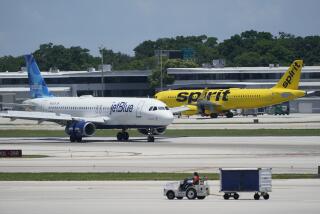Consumers May Well Worry About Air Fare Competition : Merger: If USAir is gobbled up, service may become more convenient, say some authorities, or just more expensive.
- Share via
If the big airlines get bigger, but the number of major U.S. airlines gets smaller, what does that mean for consumers? At best, say several authorities, a little added convenience. At worst and more likely, higher prices.
Last week, millions of travelers found themselves suddenly confronting these prospects head-on. Company officials acknowledged that United Airlines (the nation’s third-leading carrier of passengers last year, with 74.1 million) and American Airlines (the second-leading carrier, with 81.1 million passengers) have each been in discussions with the parent firm of USAir (the fourth-leading carrier, with 59.5 million passengers).
If some of those talks bear fruit, either United or American could gobble up USAir, and instead of choosing among 10 billion-dollar-a-year “major” air carriers, American travelers would have nine.
At press time Wednesday, USAir spokesman Rick Weintraub was warning that talks were preliminary, complex and could lead in various directions or nowhere at all. (British Airways has a 22% voting stake in USAir, and investor Warren Buffett has 10% through his firm Berkshire Hathaway.) But Weintraub also pointed to some prospects that could give an airline executive encouragement: American and United airlines, he said, each have route systems that overlap little with USAir’s mostly East Coast route list, which features hubs in Pittsburgh, Baltimore and Charlotte, N.C. And after years of billion-dollar losses, United, American and other major airlines are again showing substantial profits, allowing them to think about acquisitions. (USAir reported losses of $2.3 billion from 1992 through 1994, but it, too, expects to report a pretax profit this year.)
Weintraub disputed the idea that an acquisition would push fares up, noting that “USAir is very rarely the initiator” of fare wars.
But consumer advocates offered various reasons for travelers to be wary. They made some observations aimed specifically at a merger of USAir and United (judged by some to be the more likely-to-succeed suitor), but many others had to do with the consolidation of airlines. Whether or not a USAir deal happens, these are possibilities for a traveler to bear in mind.
“Overall, it would represent an additional concentration in an industry that doesn’t need any more concentration,” said Ed Perkins, editor of the Consumer Reports Travel Letter. “I don’t think anybody would be better off if either American or United increased their share of the domestic market.
“The other side of the coin,” he continued, “is that USAir has never been a particularly consumer-friendly or innovative airline.” If other carriers took over USAir’s routes, “very few people would care if it disappeared from the face of the earth,” Perkins said.
Unfortunately, Perkins said, “I don’t think either United or USAir has been much of an innovator in the low-fare field. I think they’ve been followers, not leaders.” He cited the introduction of Shuttle by United last year in California and the West as merely a competitive response to the advances of Southwest Airlines.
Randy Petersen, Colorado-based publisher of InsideFlyer magazine and one of the nation’s leading authorities on frequent-flier programs, laid out a list of consequences travelers could expect from a USAir acquisition.
Anyone who doesn’t expect reduced competition to boost fares, he said, should consider the rise of fares at Denver International Airport after Continental curtailed its service there, leaving United in a dominant position. “That has cost the people in the state of Colorado tens of millions of dollars or more, paying a premium on airline tickets because there’s no competition,” Petersen said. “United has proven to be very revenue-oriented.”
Petersen also said that travelers in USAir’s Frequent Traveler program, who have no expiration date on the miles they earn, could find themselves in the hands of the United program, under which mile credits expire after three years.
One thing USAir customers shouldn’t worry about, Petersen said, is losing their mileage credits. “There is no way that that scenario would ever happen. I would bet everything I have,” he said.
On the brighter side, USAir customers could for the first time have a chance to use mileage credits to reach many new destinations (including Hawaii) that United covers but USAir doesn’t. And United customers could find they have more attractive destinations to choose from, if USAir’s partnerships with British Airways remain in place.
Con Hitchcock, attorney and aviation specialist for the Washington consumer advocacy group Public Citizen, agreed that the disappearance of a major carrier would make it easier for carriers to raise prices. But “I don’t see anything inevitable about further concentration,” Hitchcock added, noting that both TWA and Continental “have been written off as goners many times, and they’ve kept coming back.”
Reynolds travels anonymously at the newspaper’s expense, accepting no special discounts or subsidized trips. To reach him, write Travel Insider, Los Angeles Times, Times Mirror Square, Los Angeles 90053.
More to Read
Inside the business of entertainment
The Wide Shot brings you news, analysis and insights on everything from streaming wars to production — and what it all means for the future.
You may occasionally receive promotional content from the Los Angeles Times.











